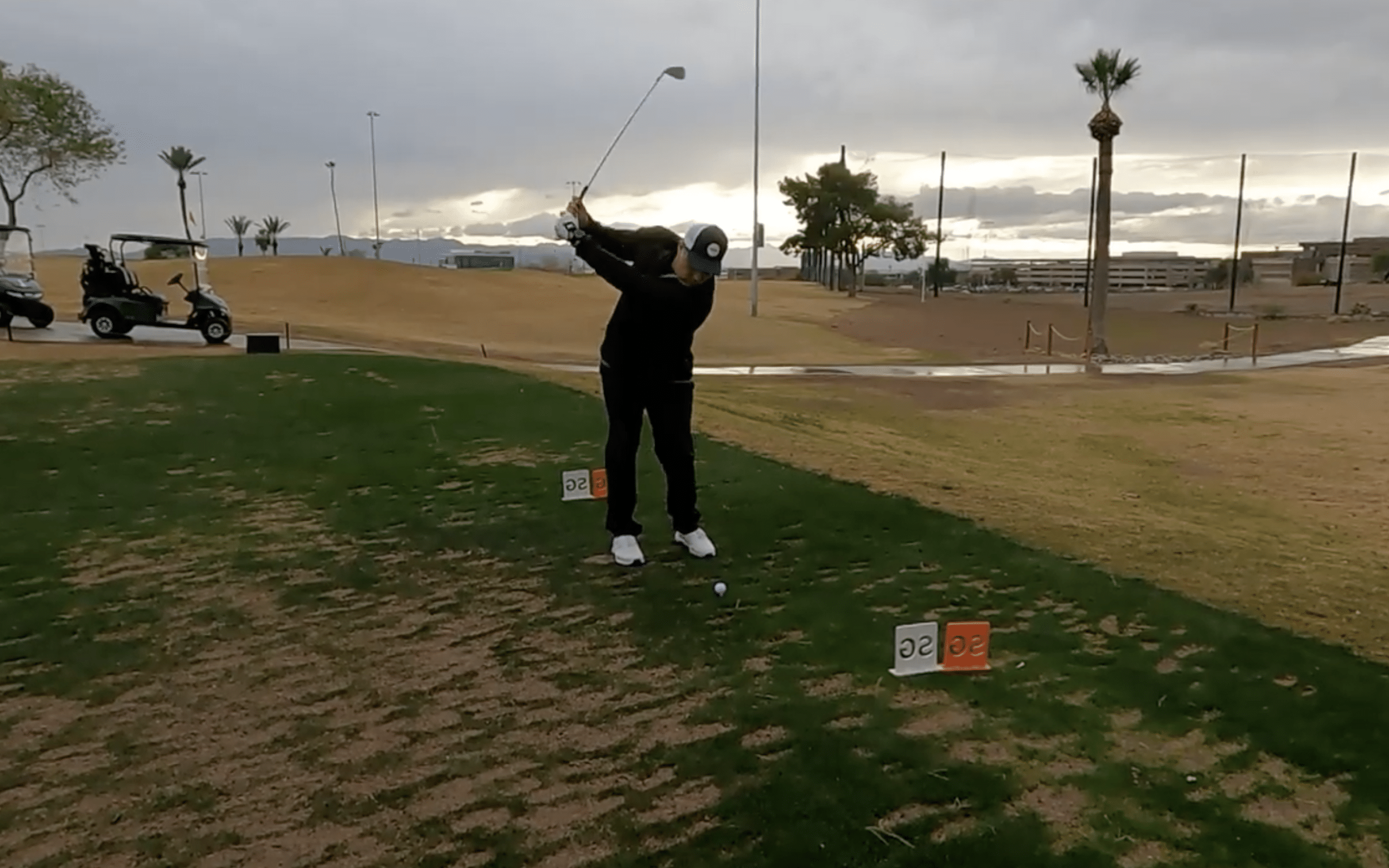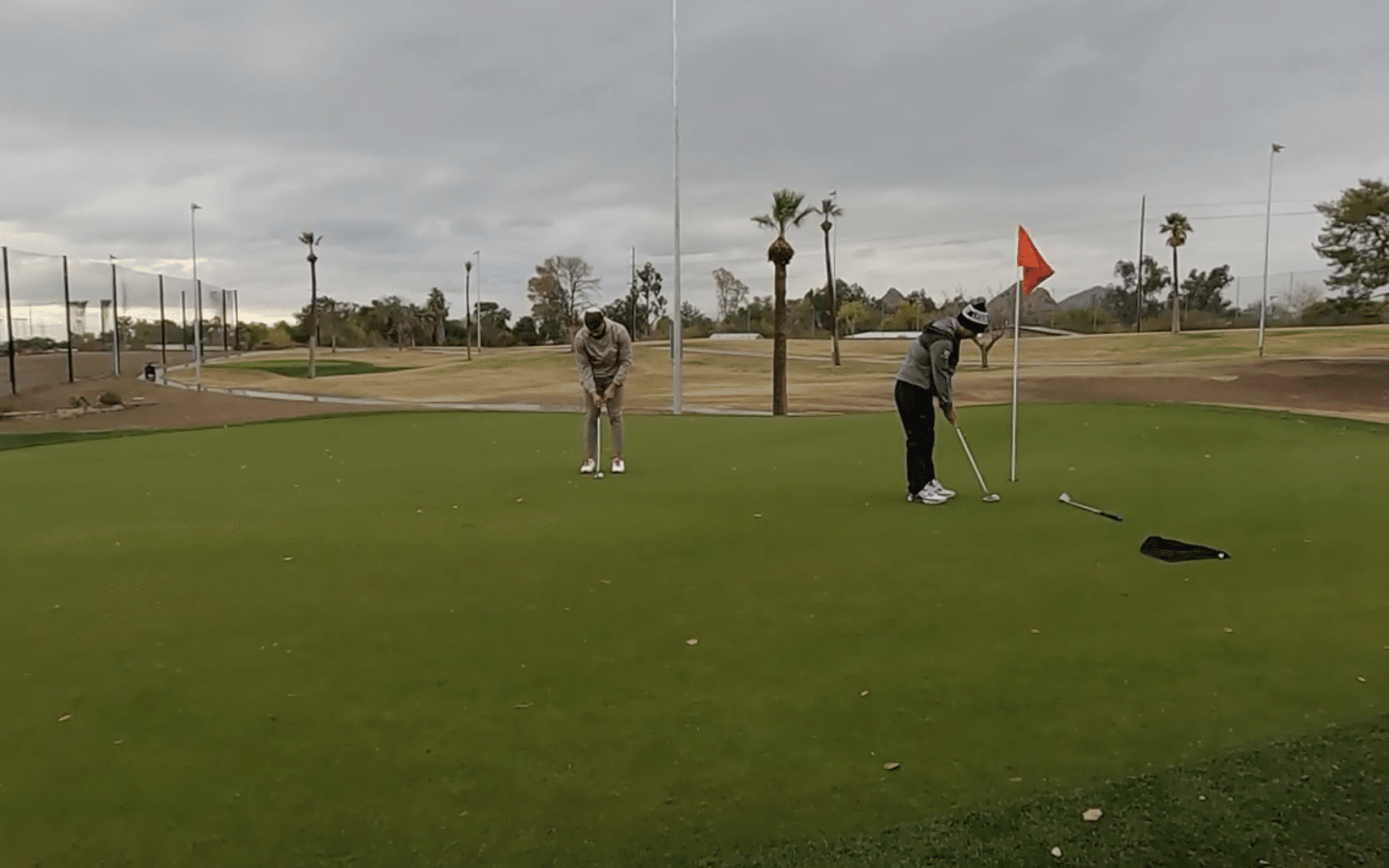To put backspin on your golf ball, you'll need the right setup and technique. Use a higher-lofted wedge (56° to 60°) with clean, sharp grooves and position the ball slightly back in your stance. Create a steep, descending attack angle by keeping your hands ahead of the ball at impact—this compresses the ball against the clubface, generating essential friction. Strike the ball initially, then the turf, while maintaining firm wrists throughout the swing. Perfect these fundamentals to reveal advanced spin techniques.

When you strike a golf ball with your club, you're creating a fascinating collision that generates backspin through two key forces working together. The normal force compresses your ball like a spring, while the tangential force at the contact point creates that coveted spin. The important part is—your ball actually rolls with some slip against the clubface, which limits how much backspin you can achieve.
The magic happens when friction slows your ball's forward momentum, creating the backward force that induces spin. Once airborne, backspin produces lift force, keeping your ball flying longer and giving you better distance. Those dimples aren't just decoration—they create turbulent airflow that reduces drag and makes your backspin more effective! Clean, sharp contact enhances this friction, especially with wedges. Higher loft angles naturally increase your backspin potential by creating a steeper angle of attack. For optimal results, position the ball slightly back in your stance to ensure you strike the ball before making ground contact. Maintaining clean grooves on your clubface is essential to maximizing the friction needed for effective backspin generation.
Three key pieces of equipment can make or break your backspin game: your wedges, your golf balls, and how well you maintain both. Blade-style wedges with sharp grooves are your best friend here—they grip the ball like nobody's business. Higher lofted wedges (56° to 60°) create more spin than lower lofts, so grab that sand wedge for maximum effect!
Your ball choice matters just as much. Premium urethane-covered balls spin way better than cheap distance balls. Tour-level balls cost more, but they're engineered specifically for backspin control.
Here's the thing: dirty grooves kill spin faster than anything. Clean your wedges before every shot, keep them dry, and replace them when the grooves wear down. Pro golfers replace wedges every few months for good reason! Most recreational golfers should replace wedges every 60-80 rounds to maintain optimal groove sharpness and spin performance. A clean, dry clubface is essential for maximizing friction and generating the backspin you need for those shots that stop on a dime.
Different wedge grinds are designed to suit specific swing types and course conditions, which can significantly impact your ability to generate consistent backspin across various lies and situations.
Now that you've got the right gear, your swing mechanics become the make-or-break factor for generating serious backspin. To put it simply, you need a steep, descending attack angle that strikes the ball first, then the turf. Think of it like chopping down at the ball rather than sweeping it away.
Keep your lead wrist firm during the downswing and maintain forward shaft lean at impact. This creates the friction between your clubface grooves and the ball's dimples that generates spin. Position the ball slightly back in your stance to promote that downward strike. Maintaining proper weight transfer through impact helps ensure consistent contact and optimal spin generation.
Speed matters too, but control trumps everything. A smooth, accelerating swing through impact beats wild swinging every time. Higher clubhead speeds directly correlate with increased backspin through enhanced friction at impact. Mastering these fundamentals improves your stopping power on greens, giving you the control needed for precise approach shots. Remember, you're trapping the ball against the turf to create maximum spin loft!

Perfect contact starts with a spotless clubface—because even the tiniest bit of dirt, grass, or sand acts like a slippery barrier between your club and the ball. You'll want to clean those grooves before every spin shot, since they're designed to channel away moisture and debris while gripping the ball.
Here's the thing: you need ball-first contact with a descending blow. Keep your hands ahead of the ball at impact—this compresses it against the clubface for maximum friction. Avoid hitting behind the ball, which creates those dreaded "fat" shots that kill spin completely.
Your wrist position matters too! Maintain stability through impact rather than flipping your hands. This consistent approach, combined with clean grooves and proper contact, alters ordinary shots into spin-generating machines that dance backward on the green. Consider using soft-core balls with lower compression ratings, as they provide superior backspin performance compared to harder alternatives.
Opening your clubface slightly before taking your stance helps engage the bounce of your wedge, which prevents the leading edge from digging into the turf while maintaining the clean contact essential for backspin.
Once you've perfected clean contact and proper technique, you'll need to lock in these skills through targeted practice sessions that convert good shots into great ones. Start with the tee drill—place a tee just behind your ball and practice striking both the ball and tee. This guarantees you're making ball-first contact, which is essential for maximum spin. Next, work on the match-the-loft drill to maintain proper clubface angle through impact without delofting. For speed training, take shorter, faster swings, focusing on consistent clubhead speed. Practice with an open stance to facilitate rotation around your lead leg. Focus on shoulder rotation rather than excessive arm movement to create more natural and powerful swing mechanics. For approach shots within the scoring zone, an approach wedge with its higher loft provides excellent control and spin generation for backspin development. Ultimately, develop a slightly flexed lead wrist at impact using wrist angle sensors or devices like HackMotion for precise feedback!
While perfecting backspin technique in practice is crucial, real golf happens on courses that change constantly—and that's where matters get interesting! You'll need to adjust your approach based on what the course throws at you.
On tight lies with short grass, you can strike down aggressively for maximum spin. But when your ball sits up in longer rough, grass gets between your clubface and ball, killing friction. The key point is—you'll need to accept a more sweeping swing and less spin in these conditions.
Firm greens demand higher backspin to stop quickly, while soft, receptive greens let you dial back the spin. Clean your grooves religiously, especially in wet conditions, and consider softer urethane-covered balls that respond consistently across different lies. Position the ball in the center or slightly forward in your stance for optimal contact and spin generation.
For maximum effectiveness, aim to strike the ball between groove number two and five on your wedge face, as this contact zone produces the highest spin rates. Maintaining a controlled backswing length is equally important for consistent distance control and clean contact when applying backspin techniques.

Backspin dramatically affects your driving distance, typically changing total yardage by 10-30 yards depending on your swing. If you're spinning the ball 500 RPM beyond ideal rates, you'll lose 10-20 yards of carry because the ball climbs too high and drops short. Here's the sweet spot: faster swingers need around 2,000-3,000 RPM, while slower speeds require more spin for adequate lift and maximum distance.
You can still generate backspin with older clubs, but it'll be considerably less effective. Worn grooves reduce friction and ball grip, cutting spin rates by more than half compared to new wedges. The key point—higher lofted wedges work better even when worn, and your swing quality matters more than ever. Clean those grooves regularly and use softer balls to enhance what spin you can create!
Your ideal backspin rates depend heavily on your handicap level. High handicappers should target 2,500-3,500 RPM with drivers and focus on clean contact over maximum spin. Mid handicappers benefit from around 1,000 RPM per iron club number—so your 7-iron should spin roughly 7,000 RPM. Low handicappers can handle 8,000-11,000+ RPM with wedges for precise control and aggressive pin attacks.
At mountain courses, you'll notice your backspin becomes less effective due to thinner air. The reduced air density means your spin won't grip the air as much, causing shots to fly straighter but flatter. Your wedges won't stop as quickly on greens, leading to more rollout. You'll need to club up and aim shorter since balls carry farther but hold greens less effectively.
You should definitely prioritize fundamentals initially before chasing backspin. The point is—without solid contact, proper grip, and consistent swing mechanics, you'll just frustrate yourself trying advanced techniques. Focus on hitting the ball cleanly and controlling distance initially. Once you're making reliable contact and your swing feels natural, then you can start working on spin techniques that'll actually improve your scoring.
You've got the tools to make your golf ball dance on the greens! Remember, backspin isn't just about looking cool—it's about controlling your shots and lowering your scores. Start with clean contact, practice those attack angles, and don't forget to experiment with different wedges. The more you work on these techniques, the more confident you'll become. Now grab your clubs and start spinning those balls like a pro!